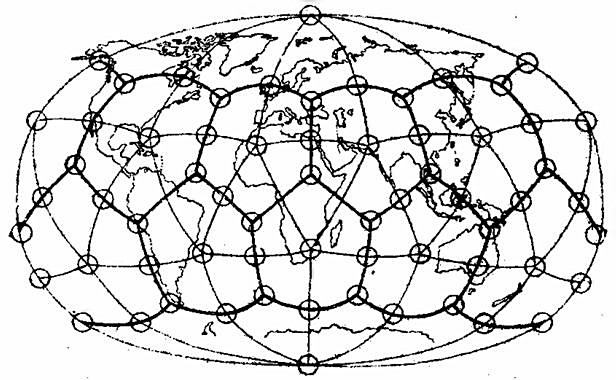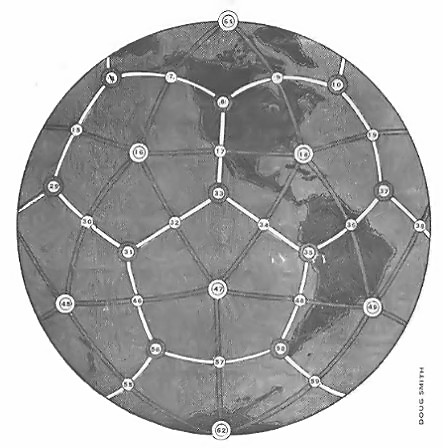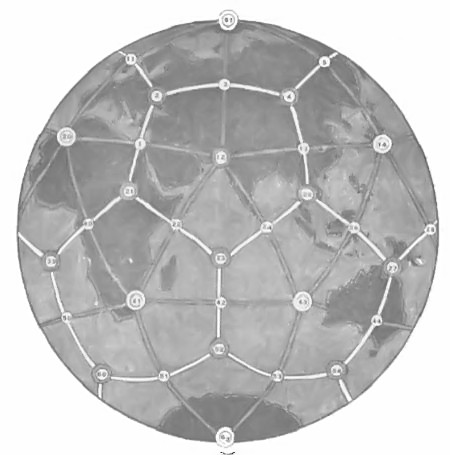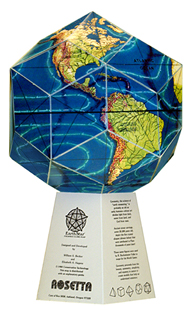
Planetary Grid
by Chris Bird
That our Earth and all matter upon it, whether held to be "living" or "non-living," is but the final result of a transformation of energy has long been suspected by metaphysicians and, comparatively recently, been given support by various branches of contemporary science with physics in the van. How this energy is ordered or regulated to form matter is a fascinating question to which only a small minority has addressed themselves. Since World War II, a number of theories, some based on a host of careful observations if not strict experimental proof, have been appearing on the horizons of scientific thought which suggest that the old "aether" of ancient philosophy, tribal wisdom and turn-of-the-century physical science may not be as dead as relativistic physics seems to have proclaimed it. (See, to name one example, "Is There an Ether?" - Industrial Research, November, 1974 by Professor H.C. Dudley, Radiation Physics, University of Illinois Medical Center ).

The authors state that there is evidence that the intersections of the grid, which makes up a kind of power matrix, are activated alternately like traffic lights and operate for certain intervals of time. When they showed their grid system to a geologist, V.I. Avinsky, he affirmed that the earth is in no way an ideal sphere, but a so-called cardioid, with convexity and concavity, the divergences of which correspond exactly to the intersections of the grid over the globe. They go on to maintain that at one of these points (intersection 40) in the new African republic of Gabon , there was recently discovered a "natural atomic reactor" which operated over 1.7 billion years ago and at which a concentration of U-235 reached a level necessary for the beginning of a chain reaction. Among other anomalies presented by the grid, the authors cite the presence of large deposits of mineral ores which lie along the faults or folds of the earth's crust and often follow the grid's ribs. Rich oil deposits, such as the gigantic Tyumen oil field (intersection 3) have been found where ribs cross. "Is it possible," write the authors, "that our dodecahedral-icosahedral system can be of more than theoretical interest for geologists, geophysicists, and geochemists?" The research trio notes that global geological structures have begun to be examined from outer space, both by astronauts and through pictures taken from satellites. Some of these have already been correlated with the ribs of the grid. The Russian cosmonaut, Sevastyanov, has written that the Ural fold region projects further to the South than is shown on existing maps, extending almost all the way to the Persian Gulf along one f the ribs. A gigantic fault from Morocco to Pakistan , neatly coinciding with the icosahedral rib (from intersections 20 to 12) has also been determined from space.

The authors claim that their examination of color photographs taken from Gemini spacecraft have revealed to them clearly circular geological structures some 200-300 kilometers in diameter which are located in Morocco (intersection 20), California (intersection 17) and near Florida (intersection 18). Study of geochemical and biochemical phenomena, the authors hold, may tend to bear out that the "earth crystal" will prove to have had, and to have, an important effect on the planet's biosphere. They state that in Europe and Asia (intersections 2 and 4), there are two large biochemical regions in the soils of which one type of element is lacking while others are in excess. This has led, in turn, to special developments in the natural selection of plants and animals. At Lake Baikal (intersection 4), according to the authors, three quarters of the animals and plants are unique. Since ornithologists these days favor the idea that migratory birds may unerringly voyage due to their sensitivity, to the earth's magnetic field, the authors ask whether the major regions for the wintering of birds occurs at certain intersections of they system (12, 20 and 41). Even man, say the authors, has been unable to escape the influence o the earth-crystal on the biosphere of which he is a part. Maintaining that cultural development itself could have been accelerated by the energies emitted at intersections of their grid, they believe that their supposition is partially borne out by the fact that the birthplaces of such ancient cultures as the Egyptian at the mouth of the Nile, the Mohenjo-Daro in the Indus Valley, Ancient Ireland, Peru, Easter Island, Northern Mongolia and others are located right at the intersections of their system. They state that by using the location of the pyramids at Gizeh as intersection 1, they can construct the entire grid system to conform more fruitfully to all the anomalies listed above than by using geological, geophysical or any other guidelines. Commenting on the Khimiya I Zhizn' article, M. Favorskaya, a doctor of mineralogical sciences writes: "Geologists are becoming increasingly interested in the relationships between zones and junctions on our planet and long-established geochemical and thermal activity. These phenomena evidence the existence of anomalies in the earth's structure and provide cause for investigating the reasons for such irregularities. The problem becomes even more interesting in light of the fact that, in many cases, there is a correspondence between large deposits and these active zones." She reports that at the International Volcanological Symposium held in Bucharest , Rumania , in September 1973, a Czech scientist (Ya. Kutina) presented a paper entitled "The Planetary Network of Faults and Its Significance in the Prognosis of Ore Deposits," according to which the junctions of a network were located at equal distances from one another. While suggesting that the hypothesis that the earth may be a crystal is most intriguing. Favorskaya stresses that, as a geologist, she was interested in the amount of evidence its authors put forward and adds that their statements regarding a "periodic activization of the system's junctions" is in agreement with the current conceptions of many geologists and mineralogists. A great deal of work remains to be done to prove out the theory concludes Favorskaya. To further tantalize young Soviet readers into study of the Concharov-Morozov-Makarov hypothesis, the editors of Komsomol'skya Pravda printed an illustration of a sphere with "horns," thirty eight examples of which were found, made of gold, in Vietnam and one, of bronze, in France. The shape of these spheres and the markings upon them, say the editors, have not been understood by scientists. Some have maintained that the spheres represent calendars, others that they are astrological symbols of some kind. "As you may have guessed," they continue, "the three researchers, Goncharov, Morozov and Makarov have their own interpretation: does this object not resemble their structural model in number of edges and nodes?" Even before the article on the earth-grid had appeared, Tekhnika I Molodezhi (Technics and Youth), one of the USSR's leading journals for popular science, came out in September 1973 with an article by Vitaly Kabachenko, a sculptor from Sochi, a Georgian seaside resort on the Black Sea. "While studying photos of the earth taken from space," it began, "I have discovered an effect of integration: a deep-seated structure of the lithosphere (the upper hard core of the earth) which sometimes literally 'shines through' accumulated sediments so that the topography corresponds to subsurface structures." Kabachenko's article, entitled "Discovering Invisible Links" indicates that the starting point of his studies was a collection of geological maps. Like Goncharov, Marozov and Makarov, he detected - with what seems to be an artist's "third eye" - a kind of grid upon them, though on a much smaller scale and composed of squares. This grid he interprets as the projection of a three-dimensional cubiform lattice around which the structure of the lithosphere is organized. Stating that it would be logical to conclude that the lattice is not only within the earth itself but also above its surface, Kabachenko reasoned that its presence should be detectable in the structure of mobile media such as water and clouds and that whatever has taken place in the lithosphere over millions of years at a slow pace, must take place in water and clouds much faster, within hours or minutes. Kabachenko asserts that he has verified this assumption through the study of many pictures taken from planes and satellites. "I have noted on many occasions how, in the sky, a barely noticeable network of nebulous streaks form," he writes. "They gradually expand and the network becomes less and less clear among the thickening clouds. I also observed how on the surface of the ocean, black streaks would appear and intersect one another at the same angles. More surprising is the fact that clouds corresponded to the dark streaks. This phenomenon, systematically repeated, led to the following idea: the grid of streaks on the surface of the ocean must in turn reflect the structural peculiarity of the ocean bottom. This means that by looking at a photo taken from space one might forma picture of the structural peculiarities of the lithosphere by examining the lace-like structure of clouds and dark streaks of the hydrosphere. I call this phenomenon 'the effect of regularity.'" Kabachenko suggests that ore deposits in the planet might be concentrated in zones, which cannot always be clearly seen under the mantle of sediments, and that the study of clouds and the ocean might provide an "X-ray photo" of the deep-seated structure of our earth. Then, abruptly, Kabachenko seems to anticipate part of the findings of the research trio as set forth above. "On pictures of the earth taken from space probes," he writes, "it can be clearly seen that with an increase in the altitude from which they are taken, the smaller grid contains elements of a larger structure which basically characterizes the face of our planet." To explain the invisible but all-permeating structural network he believes he has come upon, Kabachenko points to an experiment performed at the Institute of Crystollography of the USSR Academy of Sciences by a doctor of physical and mathematical sciences, G.I. Dietler in 1963. Dietler covered the surface of a tiny seed crystal with an insulating film of paraffin and put it in a solution made up of a super-saturated solution of a given compound. He was surprised to note that the tiny crystal began to grow as if there were no insulating film. The deposition on the film went on as dictated by the structural seed. This remote effect can be explained, according to Kabachenko, by the fact that information on the structure of the tiny crystal was "recorded in the form of electrical fields which were not fully shielded by the film. The same could have happened on our planet, according to Kabachenko, the lithosphere's formation having depended upon the electrostatic field of the earth which is only beginning to be studied. Kabachenko's theory was commented on by Dr. Bladimir Neiman, a geologist and mineralogist, who noted that for a long time specialists have pointed to various manifestations of regularities and discontinuities of terrestrial structures. The dean of the Moscow Institute of Engineering, Geodesy, Aerial Photography and Cartography, V. Piotrovsky, showed that dimensions in the earth's relief are not random but distributed in definitive groups, or clusters. An amateur astronomer, M. Shemlyakin, says Neiman has determined that chains of craters on the moon form series wherein the diameter of each successive crater is the square root of 2 greater than the preceding one and that the distance between the centers of the craters changes correspondingly. Neiman, who has published a book on the transmutation of elements, a theory thus far also enunciated only by the French savant, C. Louis Kervran, says that he has the notion that elements may have evolved on earth in a similar way proceeding from Nitrogen to Silicon to Iron to Cadmium to Radium according to the formula: N-14 to Si-28 to Fe-56 to Ca-112 to Radium-224, with the atomic weight doubling over a strictly determined period of time. In other words, the regularity can be seen not only in space but in time as well. Neiman claims that Kabachenko has studied hundreds of aerial photos from which he has determined a system of known - as well as unknown but predictable - geophysical fault zones, which tie into a single global network. This hierarchy of zones, ranging from extremely large to extremely small, he then mentally extends down into the finest crystalline structures. His whole grid system thus resembles lattices within lattices, all of different orders of magnitude, to make up a general lattice of the entire universe. Having found that clouds seem to form along the rods of the lattice, and extending this conception to solid bodies, Kabachenko, reports Neiman, learned to feel the dynamics of terrestrial elements. With his apparent supersensory powers, he has also found anomalies in the pictures of structures on the moon and Mars. From his studies he believes that in a zone where two unequal "halves" join, a "fusion of matter" takes place, the fusion following a spiral path winding its way around one of the rods of the lattice. "Looking with Kabachenko's eyes," writes Neiman, "I also begin to notice the same thing. I believe the reader can notice it too. By adopting this point of view one inescapably comes to the conclusion that the opposing parts - the "beginning" and the "end" - of any formations of geological elements must be unequal and polar in nature. Take the Urals for instance (one could take another area just as well). That mountain range begins by zigzagging in the Arctic . Continuing southwards, it suddenly becomes wider at the latitude of Sverdlovsk . What happened to the easternmost strip of Urals north of Sverdlovsk ? Neiman regrets that hardly any study has been given to the question of polarity. As for the "lattice of the univers," as he and Kabachenko dub it, Neiman holds that within it are located not only planets and stars but galaxies and intra-galactic space as well. Stating that many scientists rely on the concept of a primordial initial chaos to explain the formation of the cosmos - meteorites coming together at random to form planets, life arising from randomly coalesced organic molecules - Neiman says he rejects this idea. "Rather," he writes, "one may assert that there exist in nature regulatory pulsations correlating the actions of its separate links by magnifying some phenomena and minimizing others. For example, a Moscow engineer has determined that at times of alignment of the Earth, Mars and Jupiter, the temperature on earth increases sharply and that, simultaneously, the number of sunspots increases and the so-called proton flares occur (as studied by V. Kozlov, a member of the Kola-Peninsula branch of the USSR Academy of Sciences)." "It is the lattice," writes Neiman, "that governs the path of the pulses through space. Each group of signals travels along the faces of the lattice. It is not by chance that photos taken in polarized light reveal the lattice much more clearly. The lattice also accounts for the appearance and preservation in space of such two dimensional formations as the rings of Saturn and, on Earth, of these regular systems of fissures which geologists call faults or linear structures which are accompanied by high electrostatic fields. At the nodes of the lattice where three groups of signals intersect, or are 'focused,' are the locations where matter most probably is created. And depending on the order of magnitude of the lattice, various 'point-like formations' are brought into being such as planets, stars and galaxies. "The very possibility that something can be 'born out of nothing' (actually at the expense of the energy forms of matter) has already been theoretically predicted," stresses Neiman. "If this is so, then there is undoubtedly a reverse process in which matter disappears into 'black holes'." The ideas of the fusion of matters taking place in a spiral fashion are reminiscent of a number of theories not the least is that of the late Dr. Wilhelm Reich, who claimed that the life force, or aether, which he called orgone, traveled in spiral waves which, when superimposed on each other, caused the creation of matter. It would be of great interest to learn if readers of The New Age Journal can adduce new evidence in support of the hypotheses advanced by the Russians with whom the author is in contact.
Chris Bird is a contributing editor to NAJ and co-author of the best-seller, The-Secret Life of Plants. I Bethe Hagens reprint this article with the kind permission of New Age Journal (no longer in publication) from its May 1975 edition. The copyright is held by Rising Star Associates Limited, Partnership, 342 Western Avenue, Brighton, MA 01235 with all rights reserved.
If you like this, you'll love the Becker-Hagens EarthStar Globe.

The flat EarthStar map (made up of thirty diamonds) folds up into a globe. Globe on its stand is 10.75 inches high. Available exclusively here at VortexMaps.com
$25 includes free shipping worldwide.
Daniel Evan Shaw, Copyright © 2022